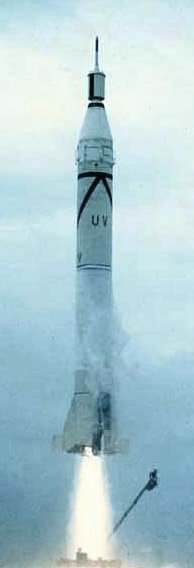- Juno I
Infobox rocket

imsize = 200
caption =Juno I satellite launch vehicle. (USAF)
name = Juno I
function =Orbitallaunch vehicle
manufacturer =Army Ballistic Missile Agency
country-origin =United States
height =21.2 m (69.5 feet)
alt-height =
diameter =1.78 m (5.8 feet)
alt-diameter =
mass =29,060 kg (64,070 lb)
alt-mass =
stages =4
LEO-payload =11 kg (24 lb)
alt-LEO =
payload-location =
payload =
alt-payload =
status =Retired
sites =LC-5 and 26A, Cape Canaveral
launches =6
success =3
fail =3
partial =
first=February 1 1958
firstorbited =Explorer 1 February 1 1958
last=October 23 1958
stage1name =Redstone (stretched)
stage1engines =1 A-7
stage1thrust =42,439 kgf (93,562 lbf)
alt-stage1thrust =
stage1SI =235 sec
stage1time =155 seconds
stage1fuel =LOX /Hydyne
stage2name =Sergeant cluster
stage2engines =11 Solid
stage2thrust =7,480 kgf (16,490 lbf)
alt-stage2thrust =
stage2SI =214 sec
stage2time =6 seconds
stage2fuel =Solid
stage3name =Sergeant cluster
stage3engines =3 Solid
stage3thrust =2,040 kgf (4,500 lbf)
alt-stage3thrust =
stage3SI =214 sec
stage3time =6 seconds
stage3fuel =Solid
stage4name =Sergeant
stage4engines =1 Solid
stage4thrust =680 kgf (1,499 lbf)
alt-stage4thrust =
stage4SI =214 sec
stage4time =6 seconds
stage4fuel =SolidThe Juno I was a satellitelaunch vehicle , derived from, and commonly confused with, theJupiter-C sounding rocket. It is most well known for launching America's first satellite,Explorer 1 .It consisted of a Jupiter-C rocket, with a fourth stage mounted on top of the "tub" of the third stage. The fourth stage was fired after the third stage burnout to boost the satellite to an orbital velocity of 18,000 mph (8 km/s). The fourth stage would also enter orbit itself.The Juno I obviated the need for a guidance system in the upper stages, and was invented by
Wernher von Braun in 1956 for his proposed Project Orbiter, which would have been just like the Jupiter-C but using the even smaller solid-fuel upper stages which were the only ones available at that time. His method was the simplest and most immediate method for putting a payload into orbit, but as it had no upper-stage guidance, it was not put into a precisely specified orbit. The name derived from von Braun wishing to make the rocket appear as peaceable as theVanguard rocket , which was not a weapon, as the original Jupiter was, but was developed from a weather study rocket, the Viking.Americans cheered on the orbiting of these early Explorer satellites, not realizing that it was by a means inferior to that of the Russians - or of the U.S. Navy's
Project Vanguard . Von Braun had the method used again in the Juno II, which used a real Jupiter first stage rather than a Redstone. No other nation has since used this method. clarifyme|reason=What method?|date=October 2008{1|}Specifications
* Weight as configured for
Explorer 1 launch, loaded/empty
** Overall, takeoff: 64,000 lb (29,000 kg)/10,260 lb (4650 kg)
** Stage 1 62,700 lb (28,400 kg)/9,600 lb (4,400 kg)
** Stage 2 1,020 lb (460 kg)/490 lb (220 kg)
** Stage 3 280 lb (130 kg)/140 lb (64 kg)
** Stage 4 80 lb (36 kg)/31.5 lb (14 kg)
* Propulsion
** Stage 1:Rocketdyne A-7 engine
*** Thrust, 83,000 lbf (370 kN)
*** burning time, 155 s
*** specific impulse, 235 s (2.30 kN·s/kg)
*** propellants, liquid oxygen, as oxidizer, and "Hydyne" (60% unsymmetrical dimethylhydrazine and 40% diethylenetriamine), as fuel
*** propellant feed, turbopump type
*** turbopump drive, 90% hydrogen peroxide decomposed by catalyst bed to produce steam
** Stage 2: Eleven JPL scaled-down Sergeant rockets
*** Thrust, 16,500 lbf (73 kN)
*** burning time, 6.5 s
*** specific impulse, 220 s (2.16 kN·s/kg)
*** propellant, polysulfide-aluminum and ammonium perchlorate (solid propellant)
** Stage 3: Three JPL scaled-down Sergeant rockets
*** Thrust, 4,500 lbf (24 kN)
*** burning time, 6.5 s
*** specific impulse, 235 s (2.30 kN·s/kg)
*** propellant, same as for Stage 2
** Stage 4: One JPL scaled-down Sergeant rocket
*** Thrust, 1,500 lbf (8 kN)
*** burning time, 6.5 s
*** specific impulse, 235 s (2.30 kN·s/kg)
*** propellant, same as for Stage 2Launch History
January 31 ,1958 : OrbitedExplorer 1 satellite weighing 30.66 lb (13.91 kg) with 18.35 lb (8.32 kg) of payload, perigee 224 mi (360 km), apogee 1,575 mi (2,535 km). Explorer 1 ceased transmission of data onMay 23 ,1958 , when its batteries died, but remained in orbit for more than 12 years. It made a fiery reentry over the Pacific Ocean onMarch 31 ,1970 .March 5 ,1958 : Attempted orbit ofExplorer 2 weighing 31.36 lb (14.22 kg) with 18.83 lb (8.54 kg) of payload failed because fourth stage did not ignite.March 26 ,1958 : OrbitedExplorer 3 satellite weighing 31.0 lb (14.0 kg) with 18.53 lb (8.41 kg) of payload, perigee 119 mi (192 km), apogee 1,740 mi (2,800 km). DownJune 28 ,1958 .July 26 ,1958 : OrbitedExplorer 4 satellite weighing 37.16 lb (16.86 kg) with 25.76 lb (11.68 kg) of payload, perigee 163 mi, apogee 1,373 mi (2,210 km). DownOctober 23 ,1959 .August 24 ,1958 : Attempted orbit ofExplorer 5 satellite 37.16 lb (16.86 kg) with 25.76 lb (11.68 kg) of payload. It failed because booster collided with second stage after separation, causing upper stage firing angle to be off.October 23 ,1958 : Attempted orbit of 12 ft (3.7 m) inflatable Beacon satellite 31.5 lb (14.3 kg) with 18.3 lb (8.3 kg) of payload. It failed when second stage separated prematurely from booster."Source: Data Sheet, Department of Astronautics,
National Air and Space Museum ,Smithsonian Institution ."
Wikimedia Foundation. 2010.
